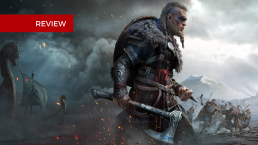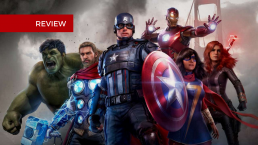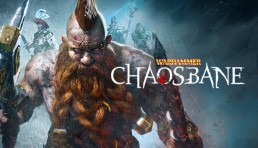Review | Spider-Man: Miles Morales
Spider-Man has always been with the themes as a formula. This is no different in this spin-off, which revolves around Miles Morales, a young man whose mother fights in politics against corrupt politicians and rogue companies. The central theme is electricity. You notice it in the story, but also in Miles Morales himself, electricity is what distinguishes him most from Peter Parker.
Miles can energize his body with “venom”, a kind of orange lightning. With venom, he can hurl enemies through rooms, make them immobile, or simply provide them with an electric shock. He also uses electricity in puzzles. Miles needs, for example, to charge generators or connect electricity networks to venom.
Electricity also plays a major role thematically. A new energy company, Roxxon, appears to have a very big say in New York City’s work. Roxxon’s motives therefore seem double. Miles’s mother, who still has to recover from the loss of her husband in the first part, therefore turns to politics.
There is therefore a lot, um, tension (see what i did there :p ) between the family members. And then there is Miles’s best friend, who, together with her brother and Miles herself, is closely involved in the development of new technology. They are working on a new form of energy that could replace electricity: NuForm.

The story in Spider-Man: Miles Morales is a bit silly, but the game gets away with that because even the somewhat silly narrative brackets remain entirely within the acceptable comic book spectrum. This game contains some strong and genuinely emotional narrative moments. Developer Insomniac Games does that very well. Miles Morales goes through bizarre things, but feels more human than superhero.
Peter Parker doesn’t play a big role in this story, if you think that after the trailers. He is going on vacation with his now well-known girlfriend, and so Miles, for the first time, has to take over from him for a week or two.
This part was therefore completed much earlier than the original. You’ll be through it within twelve hours, but it feels much faster. The pacing is very high and exciting turns follow each other in rapid succession. It is therefore difficult to put the controller down. Compared to the original Marvel’s Spider-Man, Miles Morales feels trim. After completing the game, you can still play the friendly neighborhood hero. Miles has his own app that residents can use to call on him. It is an ingenious alternative to a quest system.
Also interesting are the special powers that Miles has. The normal combat, against normal enemies, was a bit more aggressive in the previous part, given Miles has invisibility and Peter Parker had some strong area-of-attack attacks. Perhaps the subtlest difference between the two games is the music. Miles Morales leans a little more towards hip hop. Beats are mixed through the symphonic orchestral music, which you hear well during fights, among other things, a subtle but appropriate addition.
Spider-Man: Miles Morales will be released on the PlayStation 4, but also on the new PlayStation 5. This game is very nice on the PlayStation 5, partly thanks to ray tracing. You play at 30 fps. Without ray tracing, the game runs at 60 fps.
There is a time when ray tracing almost perfectly is on display . You then enter an enemy base under supervision. The hallway is infused with purple lighting and flashing monitors with an Outrun-esque aesthetic. In this shot, the lighting reflects on the shiny coats, but especially on the floors.
Ray tracing also gets the literal opportunity to shine on the windows of flats and in the well-placed rain puddles. Whether all of that justifies the loss of 60 fps is personal. I don’t think so. That high frame rate is really nice, especially during the hectic fights. But you have to make that decision yourself.
In the game you don’t notice much of the new adaptive triggers, although they do make sure that you have to press “harder” while spinning through the city, a great effect. The haptic feedback is not very impressive either. You only really notice when very heavy enemies thunder through the image, such as an enemy of rhino-like proportions.
Whether you play this game on the previous or the new PlayStation, Miles Morales is very rewarding. It tells a concise yet intense story, introduces some really entertaining twists, and there’s a lot to collect, solve and battle out in New York.
Score:
9,0
+ Very entertaining storyline
+ Beautifull and vivid game world
+ Ray tracing showcases beautifully
– Faster finished than hoped
Review | Assassin's Creed Valhalla
Can a game be too big? Ask anyone who played Assassin's Creed Odyssey and the answer is probably yes. Not only the game world was immense, the game itself was bursting at the seams with the amount of weapons, gear, skills, upgrades for your boat, mercenaries and cultists. Fortunately, Ubisoft has pulled out the trimmer for Assassin's Creed Valhalla, in a good way.
In Assassin’s Creed Valhalla you take on the role of Eivor and choose whether you play as a male, female or let the Animus decide for you. A completely cosmetic choice that does not change the course of the game. But because I played as a male Eivor, I refer to “him” in this review. Eivor is one of the many Vikings who left Scandinavia at the end of the ninth century and tries to settle in England.
Medieval England relied more on its natural beauty than its prominent landmarks, for even London at the time was little more than a peasant settlement built on Roman ruins. Despite its primitiveness, England at that time was a powder keg that was about to explode. The country is divided into four different kingdoms. Foreign invaders, such as Eivor, are increasing tensions. Of course The Order of the Ancients appears to be pulling all kinds of strings in the background. Before Eivor knows it, he is involved in a plot that is much bigger than his own ambition to build a settlement.
That sounds like run-of-the-mill Assassin’s Creed material, but Valhalla does a number of things significantly differently from its predecessors. Take, for example, the way the story is divided. Valhalla consists of clear Arcs, which are also presented as such. Each story arc has a clear beginning and end and always focuses on a specific area. In one story arc you have to help a local king stay in power and you fight in great battles in which you storm a castle in stages. Another storyline takes more inspiration from the classic Assassin’s Creed and relies on detective work and assassinations with the Hidden Blade.
Story missions follow each other relatively quickly within such a story arc, without the player being distracted all the time. Side missions and activities are still plentiful and you are free to undertake them whenever you feel like it, but it feels more natural to explore the land in between those story arcs. In addition, side missions no longer “pollute” your quest list: they are really meant to be done immediately and quickly in between. This creates a nice balance of playing missions, exploring the landscape and undertaking side activities.


Even during missions, Assassin’s Creed Valhalla is more reserved with its icons and clues. An example, at one point I run into two Normans who want to plunder a house. However, they do not have a torch and therefore cannot set anything on fire. And what’s looting without a bright bonfire? Instead of immediately showing what you need to do, the game leaves it to your own imagination that you can light the thatched roof with a torch.
In another mission, I must uncover a traitor. It is possible to immediately point out a culprit, but you can also interrogate people in the village or follow a whole trail into the swamp. Instead of knowing exactly how many hints you still have to collect, you now have to rely more on your own instinct.
Having to think for yourself is often a lot more fun than just running to the next arrow on the map, but unfortunately Assassin’s Creed is not always suitable for this. “Traditionally” it sometimes happens that you suddenly cannot address a character or that a required object does not want to load. Previously you had realized that it was better to reload a checkpoint, but now you regularly remain in the dark, am I doing something wrong, or is the game broken?
The slight suspicion that something is technically not going quite right is certainly not unfounded. Valhalla has the necessary rough edges. Think of hard transitions between videos and gameplay, missing sound effects or spontaneous, spastic animations. But also at gates and doors that remain closed after respawning, so that part of the men remains behind during a castle storm.
The animations during fighting don’t always look smooth either. There is a strange contrast between how flashy fast Eivor can evade and how slow he throws a flail around. With special attacks, the animations often do not quite match each other, causing Eivor to either fall into the air, or make a very strange jump.
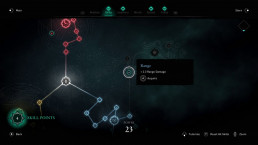
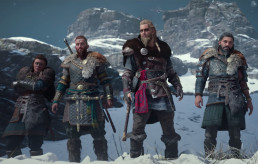
That said, fighting in Valhalla feels very satisfying once you get the hang of the combat system. It is no longer necessary to equip Eivor with new weapons on the assembly line and therefore does not always have to get used to other properties. You will find new weapons with different characteristics, but they are not necessarily better or worse than the one you already have. If you want, you can finish the entire game with the same axe.
The axe, the hammer, The Flail. Each weapon feels different, but each one gives you a sense of unadulterated brutality befitting the Vikings. Flying limbs and decapitations are therefore the order of the day. Valhalla takes some getting used to after the fairly light-hearted Odyssey, but fortunately there was also room for a humorous note in the Middle Ages.
Especially “Flyting” regularly causes a big grin on the face. In these Viking “Rap” Battles you always have to choose a phrase that not only rhymes with what your opponent just said, but also something that fits in rhythm. Eivor does not hesitate to talk about someone’s physical characteristics or mother, but finding the right diss is easier said than done. Perhaps the best side activity is the tactical dice game Orlog. The rules of the game are simple enough that you get it after one time, but complicated enough to keep you fascinated again and again.
That is actually the common thread of all of Assassin’s Creed Valhalla. Compared to its predecessor, Valhalla is a lot easier to understand, with fewer game mechanics, stats and distractions. At the same time, the content that remains is structured in such a way that you as a player are drawn even more into the game world.
Score:
8,5
+ Suitable and cool Viking weapons
+ Pleasant balance between main and side missions
+ Original and fun activities such as flyting and Orlog
+ Missions are less layed out before you
– Several bugs and technical flaws at launch
– Missions sometimes unclear
Review | Marvel's Avengers
Developer Crystal Dynamics has made it clear that Marvel's Avengers must become a living universe. With a cooperative multiplayer mode that is constantly updated with new content, Marvel’s Avengers should last for years. The story mode intended as an introduction and the cooperative multiplayer are qualitatively far apart. It's surprising that the "single player mode" is the signed winner.
The narrative part of Marvel’s Avengers knows how to perfectly respond to the inner Marvel fan by not putting someone like Captain America or Iron Man at the center, but rather the young superhero-in-the-cap Kamala Khan. The fantasy trip for Marvel fans kicks off right when Kamala enters Avengers Day, sort of an open-air Marvel convention. The biggest difference is that the visitors do not marvel at cosplayers, but at the real superheroes in the flesh. If the future Ms. Marvel suddenly bumps into Thor, she’s not the only one who squeaks with enthusiasm.
However, that euphoria is short-lived. The Avengers giant airship goes up in flames after an attack. The nasty stuff that is released during this process turns Kamala into the very flexible Ms. Marvel. Then a classic origins story unfolds, in which Kamala not only discovers her own super powers, but also brings the fallen Avengers back together.
Although the story does not really surprise, it is a succession of fan material. In addition to Kamala, you regularly get the other Avengers under your control. They all have roughly the same type of attacks, such as a light and a heavy attack and a remote attack. But where Iron Man, for example, shoots with his repulsors, Captain America throws his shield , Thor with his hammer and The Hulk just pulls a fresh piece of debris from the ground towards the ill-fated enemy.
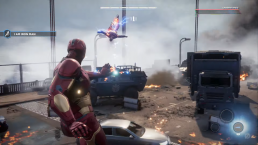
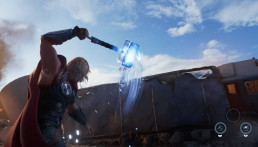
The unambiguous controls allow you to switch effortlessly between the different heroes, but you can also take the time to master a specific superhero. The story mode is not nearly enough to unlock all skills for the different heroes. This game is made to last much longer. The multiplayer DNA is deeply rooted in Marvel’s Avengers and the narrative part cannot be separated from the cooperative battles.
For example, during the “single player” you will be presented with missions several times that you can play with multiple players. If no partners are found through matchmaking, computer-controlled heroes fill in the blanks. These missions are immediately out of tune, the environments stand out against the locations you play through on your own, objectives are generic and the interaction between the Avengers lacks the credible touch that Kamala and Bruce Banner put on the stage in the beginning.
It is a shame that it has been decided to put so much emphasis on multiplayer, because at the moment there is a lot of fun to be had in Marvel’s Avengers, especially as a single player game.
That line continues unabated once you launch Avengers Initiative: the real multiplayer part of the game. This is set after the campaign, when the world is still plagued by various threats and the Avengers are needed everywhere to quell conflict. Some missions are done in minutes, others take considerably longer, but none of the online activities really surpass the single player.
Interiors are eagerly reused and usually have the ambiance of a dental practice. Usually the ultimate goal is to smash a few generators, defend a few checkpoints, or protect a few S.H.I.E.L.D agents. In addition, you should of course punch everyone you meet in the face, because that is what Marvel’s Avengers is all about: fight and fight, preferably as spectacular as possible.
Sometimes that results in unadulterated superhero fun, sometimes the chaos simply becomes too much. When vibranium shields, divine hammers, green fists, bullets, lasers, debris, robot parts and outstretched limbs fill the screen, it’s not just your eyes that struggle to keep up with the chaos.
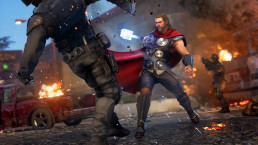

Nevertheless, there is enough in the barrel for any superhero. In addition to the missions and routine gear upgrades, there are also daily and weekly challenges that earn you points as part of the Hero Challenge Cards. You can complete those challenges anywhere. In a story mission, online, on your own: everything counts. This way you can unlock new costumes, emotes and name tags per character. The game only gets a bit of an appearance because you can also unlock everything in the Challenge Cards with real money.
If the online activities were really cool and you enjoyed playing them over and over again, that was until then. But now that the missions are also repeated after a short while, you have to grind a lot to complete the Challenge Card and thus unlock all costumes.
Marvel’s Avengers really does need some work to break through online. In addition to the fact that the missions get boring relatively quickly, the game is not entirely perfect technically. Sometimes you fall through the ground, enemies end up in closed environments and there are quite a few graphical oddities in the game. Crystal Dynamics will add new characters in the coming period, including Hawkeye, Kate Bishop, Black Panther and, exclusively on the PlayStation, Spider-Man. That will only make Marvel’s Avengers attractive to more people, as playing as your favorite Marvel hero is the game’s biggest draw.
The fighting system is right, the powers are right, the balance is right: every superhero is fun to play with. The heroes’ designs are debatable, but the unlockable costumes solve that problem for most people. It is a shame that it has been decided to put so much emphasis on multiplayer, because at the moment there is a lot of fun to be had in Marvel’s Avengers, especially as a single player game. The multiplayer is now on level The Incredible Hulk (2008). Let’s hope it doesn’t take Crystal Dynamics eleven years to reach level of Endgame.
Score:
8,0
+ the “single player” turns out to be surprisingly good
+ Great sound and special effects
+ Every superhero is well put together with their own moves and custom costumes.
– Overly cluttered War Table
– Multiplayer recycles content
– Various technical issues
Review | Gears 5 is one of the best Xbox One exclusives.
After the release of Gears of War: Judgment in 2013, it seemed that the Gears series was on its way to its retirement. Judgment was a great game, but did not reach the heights of the original trilogy. After the unveiling of Gears of War 4, the question arose whether there was still room in the current shooter genre for the once influential third-person shooter. Whereas The Coalition with Gears of War 4 was especially safe in the footsteps of Epic Games, it is now taking big leaps forward with Gears 5.
Obviously, taking on a much-loved franchise and introducing new characters, stories and gameplay elements is a tough and risky task, while the old school fans still covers the bulk of the community. For example, many thought the new protagonists from Gears of War 4 could not match the old Delta Squad. Gears 5, however, shows that Kait, Del and JD are indeed worthy successors to the heroes from the original trilogy. This time, the game does not have to have a set of new weapons and enemies, but rather a story that holds us in its tight grip from start to finish.
This is mainly due to the main characters who come into their own in Gears 5 much better than in part four. The driving force behind this story is Kait, who made a shocking discovery at the end of the previous part, causing her to be confused in Gears 5. Even before we get to work with the heroine, we step into the skin of JD Fenix, who still has a respectful admiration for his dad, Marcus. JD is all too aware of the fact that his father has meant a lot to mankind and that leaves him constantly trying to prove himself on the battlefield, much to Marcus’s annoyance. This heroic attitude leads to a catastrophic event, which unfortunately results in difficulties within Delta Squad.
This event leads us to the moment when we finally get Kait under our control. That is also the moment when Gears 5 for the first time breaks with the linear gameplay we all know and places us in atmospheric open-world areas in which we can look for missions ourselves. So we no longer have static battles to be allowed to proceed to the next checkpoint, but cross beautiful environments such as the snowy area around Mount Kadar and a desert-like area in the UIR on our skiff, a kind of sled-type vehicle. These small open worlds are limited to the two middle acts. Apart from a handful of main missions and optional side missions where you earn upgrades for veteran Jack, there is not much to do in these areas, but Gears 5’s experience of traveling from mission to mission graces itself primarily due to the interaction between the different characters during these treks are deepened.
So now it is mainly in those conversations between main characters, which gives the story a certain impact more than ever before in the series. For example, Kait and Del reflect on the history that is (not) told by the COG, their friendship with JD and whether they are on the right path themselves. They also try to put recent events in perspective. One of these recent events is the increased intelligence of The Swarm. This is not only referred to as a narrative, but also during the firefights we see that The Swarm has become much more agile, looks up confrontation and makes it increasingly difficult for the player to hide behind a crumbling wall. In short, artificial intelligence has noticeably improved since part four and requires more tactical insight than before, which greatly benefits the gameplay.

You’ll get those tactical possibilities in the form of Jack, because the gunfights becomes a lot more dynamic thanks to a number of clever adjustments to our mechanical handler. For example, Jack can now scan the area to spot enemies, regularly attack enemies, pick up command weapons and ammunition, or temporarily generate an energy shield for the player to ward off bullets. It is these types of small adjustments that, for the first time in years, give a fresh feel to the franchise.
Especially in the first and the last act there are certain scenes that will blow you over in terms of intense fighting. Gears 5 starts to go full throttle early in the game and won’t let you go until the abrupt end. Without giving away too much about the story, it seemed as if defeating the final boss was just the beginning of another act. Although the single player of Gears 5 is considerably longer than that of Gears 4, it still feels like the story is ending too quickly. However, it does not mean that I still enjoyed it immensely.
The fact that the single player campaign is so impressive does not mean that the multiplayer is subordinate to this. The multiplayer is again very strong and has largely remained unchanged. The launch of the game unfortunately brought some server problems, but in the days that followed I hardly noticed anything. Versus again consists of an arcade mode in which two teams of five compete against each other in different game modes. New to this mode is the ability to earn points during game play to unlock weapons. An important difference with the ranked mode is that the Gnasher shotgun has been removed. In addition, you playfully unlock certain skills, such as the ability to run a little faster or extra health. This makes it easier for newcomers in particular to master the game before competing against each other in Ranked mode.

The latest showpiece of the multiplayer is the Escape mode, in which a team of three players has to free themselves from a base occupied by the Swarm, which is slowly filling up with poisoned gas. The feeling that you are being chased by this gas ensures that the tension during a game of Escape is good and nerve wrecking. It’s therefore important to quickly as possible make short work with increasingly challenging waves of enemies, while ammunition is scarce. Escape excels especially at higher levels of difficulty. Because ammunition is scarce, it is important to be careful with this and stay close to your teammates. The trick in Escape is mainly to eliminate targeted enemies together before you move forward. However, it is advisable to play this mode with a solid party, since players often tend to leave the game as it gets harder.
Everything indicates that The Coalition dares to leave its permanent mark on the series. Where Gears of War 4 remained as close as possible to the essence of the series, the developer in Gears 5 implements the necessary innovations that makes Gears interesting for both fans and newcomers. The iconic gameplay has remained intact, but is now extra layered thanks to the tactical possibilities that Jack brings. In combination with the strong story, this sometimes results in memorable moments that I haven’t experienced in a Gears title since the original trilogy. Add that to the sublime multiplayer and you’ll think of Gears 5 one of the best Xbox One exclusives of recent years.
Score:
9,0
– Server problems during launch.
– Just a few side missions.
– Very abrupt ending.
+ Characters have more depth
+ Compelling story
+ Dynamic firefights that put you on the edge of your seat
+ Extensive multiplayer modes
Review | Borderlands 3
Looting and shooting has never been this great!
As progressive as Borderlands 2 was, the sequel is that traditional. At a time when, thanks to titles such as The Division, the lootshooter consists of open online worlds with a constant stream of content, Borderlands 3 remains close to the roots of the franchise. And that is absolutely fine, because the game is a fantastic cooperative loot shooter and a wonderful parody on the stream culture.
Borderlands 3 is a tour through the rest of the universe, which has been hinted at numerous times in previous games. The Calypso twins, two evil streamers with crazy followers, force Lilith, the player and a lot of old acquaintances to scour the universe for The Great Vault: the ultimate power. For those who appreciate puberty humor and were looking for a fresh setting, this is the premise for a hilarious roller coaster ride!
Leaving Pandora, which has already been chewed out, is a pleasant release, as we see when we visit the colorful new planets. Promethea is a brightly lit, futuristic city, Athenas has calming Eastern settlements and Eden-6 is a green, dangerous swamp planet. During the story, Borderlands throws 3 players between different conflicts that give each environment its own identity. On Promethea, for example, a childish war is raging between armament manufacturers Atlas and Maliwan and your Vault Hunter is embroiled in a cowboy-like blood feud within the Jakobs family.
The design of planets is grand, although loading individual areas sometimes breaks the pace of the game. It simply feels a bit old-fashioned to have to load another world instead of just chugging on with one of the vehicles. The rigid steering of vehicles is otherwise unchanged, although this is compensated by the fast Cyclone engine and above all a greatly improved fast travel system.
The downside of this traditional setup is that players have no idea of the scale of the planets, so the game often misleads you. Several times the story takes you back to a previously visited planet, where suddenly a new, large region opens up. Environments are richly filled with vegetation and all sorts of activities, so it is not striking that there are actually very few NPCs in the game world. Moreover, most of the action takes place in varied, well-designed environments.
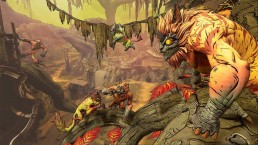
Side activities consist of crew missions, such as finding parts for a friend for Claptrap, and a considerable amount of side missions. Some contain a fun environment puzzle, but in general they must have the fantastic Borderlands humor, of which you already know if you can appreciate it. As usual, some of the best moments of the game can be found in these side missions. Think of a lurid brain transplant, setting up a network for an old pro-gamer, a shooting for the coffee supply in Promethea and even sad glimpses in the lives of characters. Ice-T, who plays the AI-driven teddy bear Balex, also deserves a compliment for his comic acting performance.
Nothing in Borderlands 3 is really serious and everywhere you’ll find comic details and references to the current internet culture. This manifests itself especially in the bad guys, Troy and Tyreen Calypso, who are actually a parody of the sometimes foolish supporters of Twitch streamers. Donations, loot boxes: it is all covered, and in my opinion largely successful. Fortunately, the background of the twins is also well deepened by their constant presence during main and side missions and they’re not only present for a smile.
Ninety percent of the gameplay consists of endless popping on screaming bullet sponges, which thanks to a greatly relaxed feeling of shooting remains fascinating for much longer than before. At 60fps (note: on the original PlayStation 4 and Xbox One consoles, the game runs on 30fps), the game even feels a bit like Apex Legends. Moving is faster, your Vault Hunter can now finally vault and sliding brings a pleasant flow to the gameplay. It feels like we can run, shoot, reload and switch weapons forever in circles.
Playing with the weapons themselves is also more fascinating thanks to a very broad randomly generated range. During your playing session you will find clearly several archetypes, but emotionally there is much more room for maneuver than in Borderlands 2. Some weapons are wonderfully exaggerated and each manufacturer brings unique bonuses, such as extra shields, reflective bullets in the event of a critical hit, infinite ammunition and shooting guns on legs. Even after about forty hours of playing, we still find plenty of new guns and with that, hunting for loot remains extremely fascinating after the story.
Weapons, as before, have elements, which means that despite aggressive opponents, players still have to think about which bullets they use. Vault Hunters also offer a deeper strategic layer thanks to the extensive skill tree. Players can now expand and mix three categories to your liking, resulting in a variety of options. For example, Fl4k can focus on a solo playing session, where his animals can revive him, or on pure damage with critical hits. The choice of a Vault Hunter – Zane, Amara, Fl4k or Moze – is therefore more difficult, and that is a nice luxury problem.
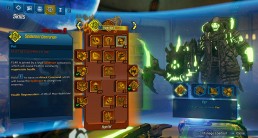
The way in which players can set up their skills also depends on whether they regularly play solo or with others. Borderlands 3 is an excellent experience on your own, but traditionally it remains superior while playing in co-op. In many ways, the game has evolved into the ultimate cooperative experience thanks to the ease with which players can enter each other’s sessions.
Moreover, loot scaling ensures that every player hits enemies and loot of his or her own level. That means that players can now play with everyone regardless of their progress. Borderlands 3 has more options that improve the quality of life. For example, it is possible to skip missions you have played with others in your own game, there is a machine that collects abandoned loot, weapons can be shared between your different characters, and it is even possible to mail weapons to each other.
And you’ll need that, because the endgame content of Borderlands 3 is quite extensive. There are Horde-like challenges in the form of Proving Grounds and Circle of Slaughter. There are also higher levels of difficulty that yield extra rare shoots after the story has been played. Add up the upcoming events and paid dlc, and I expect that i’ll continue to play Borderlands 3 for a long time.
Score:
9,0
– Loading of the maps sometimes breaks the pace of the game.
+ Planets are very varied.
+ Shooting feels good, smooth.
+ Profound skill trees.
+ Great cooperative options and gameplay.
Review | Warhammer: Chaosbane
Review | Warhammer: Chaosbane
Descend into dungeons, defeat monsters, collect loot. Yes, we have seen this before. But now it all takes place in the great Warhammer universe.
In Warhammer: Chaosbane you follow a story like many others: the world is once again threatened by chaos creatures and it needs you to save it. Nothing is more fun than hacking through hordes of enemies with skills that constantly grow in strength. Warhammer: Chaosbane knows how to evoke that feeling. Each of the four characters feels good to control and has skills that can be used in various tactical ways. Eko Software immediately wants to make it clear that the role-playing side of the game is important. You choose from the Empire Soldier, High Elf Mage, Dwarf Slayer and Wood elf Scout classes.
The first thing you notice is that your character cannot move during his or her attacks. There is also no specific action to dodge attacks. Instead, plant your feet on the ground and fire your skills at the enemies.
This may sound drowsy, but luckily it is not so bad when you unlock more skills. You receive skill points per level with which you can buy skills. The basic set is automatically unlocked, but you can gradually invest points to upgrade skills. And fortunately, those skills play very well. The Slayer has a fair amount of cool tricks in store, with some attacks costing rage points, while others feed his rage. This prevents you from constantly pressing the same button. More important are the cooldown times on special attacks, which you can only fire once in a while.
Then there’s the loot that you gradually collect. It is the standard procedure of picking up what enemies are dropping in the hope that it will yield better stats for your character. There is a shared treasure chest, so you can share your loot with other characters, you can sell them, craft them, and so on. What especially should make Chaosbane fun is the ability to play with others. There is a drop-in system where friends or strangers can accompany you in the search for better loot.
If you still want more after the story, you can dive into Expeditions, Boss Rushes and Treasure Maps. The first and the last of these, place you in a randomly generated area to perform a certain mission, often with custom elements to increase the challenge. The Boss Rushes appealed to me the most, and need you to kill a certain boss again, but this time the boss will be stronger so it also drop better loot.
My first impression of Warhammer: Chaosbane is very positive. It is very easy to get into a flow of fighting, collecting and exploring. The Warhammer license mainly feels like a new package and does not change the experience.
Score:
8,0
– Interface may be too small at several occasions
– Not enough interaction with the environment
+ Good voice acting
+ Visual stunning environments
+ Addictive gameplay
+ More than enough content
Review | Anthem
While the reviews in progress, I waited for the day one patch for the final conclusion.
Anthem tells a very and broad story that master storyteller BioWare knows how to handle and tell. At least, you would expect that. Unfortunately, the story remains safe on the surface. Just like the gameplay, the characters and the amount of content. Anthem is not a bad game, but certainly not a good one either. Does this mean that you cannot enjoy it? Certainly not! But those looking for the complete looter-shooter experience must have a lot of patience or play a different game.
Rarely did a game give a more paradoxical feeling of freedom than Anthem. Your Javelin, your personal Iron-Man suit, lets you experience a wonderful feeling of freedom with minimal effort. At the push of a button you ascend and fly just over the treetops of the truly beautiful world that BioWare has created. You avoid enemy fire with a barrel roll and while floating, you approach special enemies while using your skills. Shooting at the pretty silly and suicidal enemies is wonderful. You fire or freeze a group of enemies, and then you throw a bomb on it for a huge damage bonus.
But just when you think you are one with the world of Anthem, when you think you are an iron killing machine, the game will blow you back. You can’t stay too long, you have to keep going. And if you don’t fly to the next point fast enough, you can expect a loading screen, even though this loading interrupts part of the story you’re trying to follow.



It is symptomatic for the whole of Anthem. The game has no continuity, no immersion. Anthem does not want you to do a whole lot in one go, but to break everything into pieces that are behind a loading screen. Take as an example the equipment and weapons to be found: this is hidden in a kind of box that only when you stop your playing session shows what is in it. Stopping playing is rewarded in a certain sense, which is a bizarre and unfortunate design choice.
You always have to return to the Forge, the place where you can customize your Javelin with your finds and change the looks. There’s nothing wrong with the Forge itself: it’s a handy screen in which you quickly switch between your weapons and equipment in the form of icons. In an instant you have changed your Javelin in terms of color and cosmetic parts. You can buy cosmetic parts with real money, but also for a reasonable sum of the ingame currency. The problem of the Forge is that this part is behind a loading screen and cannot be accessed while playing. Adjusting your weapons or equipment to a situation that you had not anticipated is not possible while playing. The result is that you sometimes feel Javelin useless, while you have the right equipment in your possession.

Fortunately there are still the challenges. These challenges, ranging from killing a certain number of monsters with only a specific weapon to completing a certain amount of events, do not offer really exciting rewards, but they do give you a lot to do. There are also daily, weekly and monthly goals to complete.
You can only start the endgame yourself when you are level 30, and then it is about content that you already know, but that can then be played at a higher level of difficulty. Anthem then scatters with a good loot and that is of course great, but it also ensures that players of level 30 have quickly brought in the best loot so that there is really little left to do, apart from the challenges.
Anthem’s biggest problem, however, is that it was developed by BioWare. You can expect more from BioWare than what Anthem is at the moment. That is not entirely fair. Because when you look objectively at the game itself, it is scanty, but certainly playable. If you are only looking for simple fun shooting in a beautiful world while you fly through the air like a bird, Anthem may be something for you, because the game is really excellent. But this will be the minority. Everyone who likes to play BioWare games expects more from the story and the world. This developer invariably offers the highlights of his games there.
In addition, Anthem is not really what it promises to be. Anyone who likes to play looter shooters will notice that Anthem is actually not with the strange loot system. Anyone who likes to play co-op in a close team can do this in Anthem, but then via a Discord server, because the game itself offers a kind of pseudo team game without functional means of communication. But even the people who only come for flying and shooting will be bothered by all the loading screens and the huge amounts of bugs that the game still knows.
Of course Anthem is not the first game of the last years that has been launched with many start-up problems. Many people make the comparison with Destiny 2 and The Division and rightly claim that those games got a lot better with a lot of attention and updates after they were released. The big difference is that Destiny 2 and The Division were already great games at that time. Both had too little content and were judged on that, but the developers were able to work on it: they could immediately start expanding the game.
Anthem not only has too few exciting endgame content, but is also a much lesser game. The game gets in the way of players, and that is difficult to correct with a few patches. BioWare not only has the task to add more content, but must first make the game more playable if it is to attract and retain players. That does not mean that it is impossible for Anthem to ever become very cool, but it does not happen quickly.
Score:
7,0
– No distinctive variation in the world.
– Loading screens.
– Story filled with holes and not really fascinating characters.
+ Flying in the game world is and feels great
+ Visual a stunning spectacle

